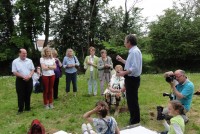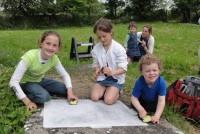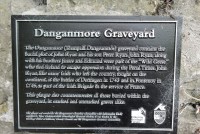Notes by Mary Casteleyn used for the unveiling of the Ryan plaque at Danganmore Graveyard, near Dunnamaggin. Friday 1st June 2012.
1. Thanks to all for the great support and interest in this project especially in these difficult times.
2. Thanks especially to Bernie Kirwan of Danesfort – a lady whose talents at deciphering seemingly unreadable stones is remarkable and without whom I would not have been able to read the inscription on the Ryan tomb here in Danganmore. Kilkenny is fortunate to have a lady with her skills; she can truly bring to life these headstones and make them yield up their hidden information; she can truly make these stones sing.....
3. Ask Bernie to read out the inscription of the Ryan tomb.A
4. When I came, just about 8 or 9 months ago, seeking this little graveyard here at Danganmore, I was pursuing a deep personal interest in the history of the Irish exiles or Wild Geese as we call them, on the continent of Europe, in the 18th century. These men and women settled in their droves in France, Spain, Portugal, Austria, the Spanish Netherlands, Germany, Sweden, Russia and elsewhere. The men went for training as Priests or doctors ( the sole profession open to them back here in Ireland) or they became merchants, often making vast fortunes by their trading abilities; often they had to live by their wits - we might now call them young men on the make. Anthony Walsh and his family, whose family came from Ballynacooly, barony of Iverk, in the Walsh Mountains, here in South Kilkenny, made a tremendous fortune trading in wine and other commodities operating out of the French ports of St Malo and Nantes. Antoine, as he is known in France, assisted with the funding of the 1745 Jacobite rebellion and he actually supplied the ship, called theDoutelle, in which Bonny Prince Charlie sailed to invade Scotland and England. At the Walsh Château de Serrant, in the Loire, there is a poignant oil painting of this ship leaving France, redolent as it was with all the hopes and aspirations of the Irish exiles. As we all know this 1745 uprising to place Bonnie Prince Charlie on the throne of England was a complete failure.
5. Anthony Walsh must have been well known to John Ryan of Danganmore who is buried here and his brothers, particularly the Chevalier Edmund Ryan; all Kilkenny men As also, without doubt, another Kilkenny man, Captain John Hennessy, also of the Irish Brigade in France, who is buried not far from here at Derrynahinch.
6. Service in the French Army was an important career move for young men such as John Ryan and his brothers James and Edmund. Certainly John fought against the English at the Battle of Dettingen in 1743 and Fontenoy in 1745 ( as part of the Wars of the Austrian Succession). Fontenoy is still remembered as it was the valour of the Irish Brigade that won the battle for the French King, against the traditional foe of England.
7. John, the eldest, resigned his commission in the French Army and was able to return to Ireland. As this was all at the height of the Penal Laws in Ireland, I suspect that some sympathetic Protestant neighbour had been protecting his interests at Danganmore. John Ryan would never have given up his career in the French Army, with salary, to return to Ireland to nothing and no prospects. He returned because he had some sort of prospects back here in Kilkenny. Someone was protecting him and we have evidence that the Ryans of Danganmore were on friendly terms with a Protestant family buried at Kells by the name of Kevan. I can only speculate about this......
8. His brother Edmond Ryan remained on the continent and became Aide to Bonnie Prince Charlie. He was commissioned to travel throughout Europe to find a bride and he had complete “carte blanche” to select a future wife for Bonnie Prince Charlie; not an easy job for the aging and somewhat difficult man Bonnie Prince Charlie had become after the failure of 1745. But imagine the standing held by Edmund Ryan, to enter the Courts of Europe, with this delicate quest - Bonnie Prince Charlie could hardly be regarded as a good catch for some European Princess; it was obvious by then that Bonnie Prince Charlie would never be King of England. Edmund Ryan must have been a born diplomat, a skilled negotiator, a tremendous linguist, (he would have known English and Irish, Latin, Greek, French, Italian and probably German) and he would have had exquisite manners to move in these high circles. And all that came out of here at Danganmore. He must have cut a very elegant figure too in velvets, satins, silks, fine linen, and lace. He was authorised to settle the marriage contact as well, which he did with Louise of Stolberg. He was also chief witness to the actual wedding which took place in Ancona, Italy in 1772.
9. John Ryan of Danganmore, buried here, was nephew to Thomas Ryan of Danganmore who had emigrated to Cadiz in Spain. This Thomas Ryan is buried in Cadiz Cathedral, having died in 1755 aged 56 years. He had married Maria Harrold, a daughter of a prominent Catholic Limerick family. To give you more of an idea of the highly aristocratic circles in which these Ryans moved, by his marriage to Maria Harrold , this Thomas Ryan became related to Baron General Harrold of the Bavarian Service, Gentleman of the Bedchamber to the Elector Palantine at Dusseldorf (being a Gentleman of the Bedchamber meant he had access to the Elector which was important and he would have had the ear of the Elector; his duties were probably quite small, like handing the Elector his gloves, when he dressed in the morning). Thomas Ryan’s sister-in-law was niece to Sir John Higgins, the personal physician to Philip V of Spain.
10. Thomas’s son Thomas Patrick Ryan was granted a certificate of nobility in Spain in 1788; his genealogy and lineage having been verified by John Ryan of Danganmore, buried here, and other Kilkenny dignitaries of the day.
11. Until recently (1999) a House of Ryan, wine and brandy merchants, was still operating in Cadiz and run by the Terry family who had married into the Ryan family in Spain.
12. Imagine if you can, all the letters flying backwards and forwards from Danganmore to places like Cadiz in Spain and to Edmund Ryan in Italy and James Ryan, still in France. Sadly they have not survived but what interesting reading they would make for us to-day if we only had access to them.
13. Here, then, in this little graveyard and with the Ryan family of Danganmore is a microcosm of the experience of all these 18th century Irish exiles, or Wild Geese, and what they managed to achieve so far from home. I am delighted the Ryans of Danganmore have been remembered by this plaque – they are worth it – and I thank all involved in this commemoration.
John Tierney of Historicgraves, The O' Neill Family, local historians John Holden and Donal Sheridan, Heritage Officer Dearbahla Ledwidge and her assistant Francis Cody, and Paul Cuddihy who endeared himself to the project from the start and for that I am truly grateful.
The Craftsmanship of the Plaque too, is very special and it is made by a local man to here, John Doyle at Signatec Knocktopher.
The graveyard of Danganmore now has a committee of neighbours and friends Chaired by John Holden to care for it into the future.
Mary Casteleyn









